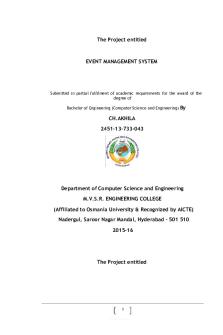Circuit Theory 2 Mini Project PDF

| Title | Circuit Theory 2 Mini Project |
|---|---|
| Course | Circuit Theory 2 |
| Institution | Universiti Kebangsaan Malaysia |
| Pages | 8 |
| File Size | 372 KB |
| File Type | |
| Total Downloads | 54 |
| Total Views | 146 |
Summary
Frequency Response Using Pspice...
Description
FREQUENCY RESPONSE USING PSPICE KKKL1123 CIRCUIT THEORY 2 ACADEMIC YEAR: SEMESTER II, 2017-2018
Project Title: Frequency Response using PSpice Objectives: 1. To learn the steps to draw circuit schematics using OrCAD Capture CIS Lite. 2. To learn the steps to simulate the frequency response of RL circuit using OrCAD PSpice. 3. To analyse the frequency response of the filter in bode plot. 4. To identify the type of filter from bode plot. Equipments: 1. OrCAD Capture CIS Lite 2. PSpice A/D Lite 3. AC voltage source 4. Resistor (1kΩ) 5. Inductor (0.1H) Methods: A. Manual Analysis 1. A circuit is drawn in frequency domain using the figure below.
2. The transfer function, Gv(jω) = Vo / Vi is obtained. 3. The poles and zeros of transfer function, Gv(jω) is determined. 4. The magnitude and phase characteristics for the bode plot for G v(jω) is plotted on semilog papers.
B. Simulation of circuit response by PSpice In Schematics: 1. A circuit schematic is drawn as shown in the figure below.
2. The simulation is started by creating new simulation profile with the name of “frequency_response”. 3. From the Analysis menu, Setup is chosen and AC sweep/Noise is then selected. 0.01, 1000k and 10 is entered into Start Frequency, End Frequency and Points/Decade respectively as shown in the figure below.
4. The simulation is started by clicking on the “Run” button in PSpice menu. 5. When the OrCAD PSpice A/D demo pops out, the “Add Trace” in the Trace menu is chosen. DB( ) is selected and put in the output node/input node. V(L1:1) is an
output node and V(V1:+) is an input node. So the DB(V(L1:1)/ V(V1:+)) is entered. The magnitude plot is shown. 6. From the Plot Menu, ‘Add Plot to Window’ is chosen. After that, from the Trace Menu, “Add Trace” is chosen. P( ) is selected and put in the output node/input node. V(L1:1) is an output node and V(V1:+) is an input node. So the P(V(L1:1)/ V(V1:+)) is entered. The phase plot is shown.
Results: A. Manual Analysis
B. PSpice
Magnitude plot and phase plot: 100d
50d
SEL>> 0d P(V(L1:1)/V(V1:+)) 0
-100
-200 10mHz 1.0Hz DB(V(L1:1)/V(V1:+))
100Hz Frequency
Discussion:
10KHz
1.0MHz
1. Based on the result obtained using manual analysis and PSpice, it can be concluded that the circuit is high-pass filter. 2. Based on the result obtained using PSpice, a high-pass filter blocks all frequencies from 10 mHz up to a cut-off frequency, 1.59805 kHz and passes the frequencies above its cut off frequency. According to the figure below, at low frequencies, the phase angle is +90o and then decreasing to almost +45o around the cut-off frequency, 1.59805 kHz. After the cut-off frequency, the phase angle will continue to decrease until 0o and remain constant afterwards.
3. The theoretical cut-off frequency can be calculated using formula below: fc =
R 2 πL
where R = resistance (Ω) L = inductance (H) Theoretical cut-off frequency, fc =
R 2 πL
= 1.592 kHz 4. The difference between the theoretical cut-off frequency and the cut-off frequency obtained using PSpice is 6.05 Hz. Thus, the cut-off frequency obtained using PSpice is close to the theoretical cut-off frequency by 0.38%. In conclusion, we can say that the cut-off frequency obtained using PSpice is almost same with the theoretical cutoff frequency.
Conclusion: In conclusion, we have learned to draw circuit schematics using OrCAD Capture CIS Lite. Besides that, we have learned to simulate the frequency response of RL circuit using OrCAD PSpice. We also learned to draw magnitude plot and phase plot of RL circuit manually. In addition, we have learned to analyse and understand basic concept of the frequency response of the filter in bode plot. Last, we have learned to identify the type of filter from bode plot.
References: 1) http://rincon-mora.gatech.edu/classes/pspicerf.pdf 2) http://stuffle.website/references/scug.pdf 3) http://home.olemiss.edu/~atef/engr360/tutorial/qgspice.html 4) http://www.uniroma2.it/didattica/Experimental/deposito/Filters.pdf 5) Fundamentals of Electric Circuits, Sixth Edition Author: Christopher K. Alexander/ Matthew N. O. Sadiku...
Similar Free PDFs

Circuit Theory 2 Mini Project
- 8 Pages

EEEN4345 Mini Project 2
- 44 Pages

MINI PROJECT
- 1 Pages

Mini Project Screw Jack 2
- 37 Pages

MINI Project
- 42 Pages

Mini project
- 110 Pages

Circuit Theory Notes explanation
- 147 Pages

Cloud Computing Mini project
- 28 Pages

Mini Project-Event management
- 46 Pages

Mini Brain Project
- 4 Pages

Mini Brain project
- 3 Pages

CG Mini Project
- 11 Pages

Mini project poster
- 1 Pages

Mini Project 1
- 4 Pages

CSC128 Mini Project Proposal
- 12 Pages

HCI Mini Project
- 11 Pages
Popular Institutions
- Tinajero National High School - Annex
- Politeknik Caltex Riau
- Yokohama City University
- SGT University
- University of Al-Qadisiyah
- Divine Word College of Vigan
- Techniek College Rotterdam
- Universidade de Santiago
- Universiti Teknologi MARA Cawangan Johor Kampus Pasir Gudang
- Poltekkes Kemenkes Yogyakarta
- Baguio City National High School
- Colegio san marcos
- preparatoria uno
- Centro de Bachillerato Tecnológico Industrial y de Servicios No. 107
- Dalian Maritime University
- Quang Trung Secondary School
- Colegio Tecnológico en Informática
- Corporación Regional de Educación Superior
- Grupo CEDVA
- Dar Al Uloom University
- Centro de Estudios Preuniversitarios de la Universidad Nacional de Ingeniería
- 上智大学
- Aakash International School, Nuna Majara
- San Felipe Neri Catholic School
- Kang Chiao International School - New Taipei City
- Misamis Occidental National High School
- Institución Educativa Escuela Normal Juan Ladrilleros
- Kolehiyo ng Pantukan
- Batanes State College
- Instituto Continental
- Sekolah Menengah Kejuruan Kesehatan Kaltara (Tarakan)
- Colegio de La Inmaculada Concepcion - Cebu